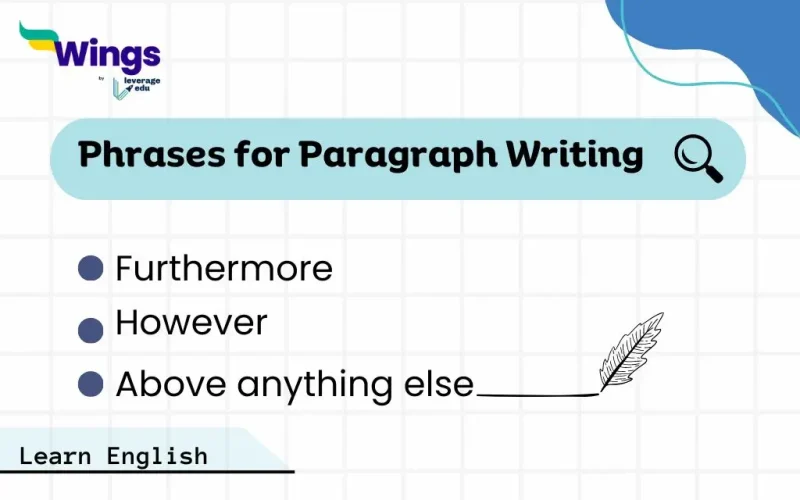Phrases for Paragraph Writing: Have you ever wondered how paragraphs are constructed in the English language? Paragraphs are groups of sentences that work together to develop a main idea. They should flow smoothly and avoid abrupt transitions. To ensure the fluency of sentences within paragraphs, the usage of English phrases is a must. Therefore, in this blog, you will explore the diverse types of phrases used in paragraph writing and how to implement them without any grammar mistakes.
This Blog Includes:
Importance of Phrases for Paragraph Writing
A paragraph may have one lengthy explanation of a general idea or several shorter ones. It is used to compare and distinguish two or more objects, and categorise, or explain causes and effects. All paragraphs, however, have the type of material they continue and have certain traits in common. A theme sentence is one of the most crucial of these.
- Moving from One Sentence to Another – Sentences and paragraphs are connected by phrases, which help the readers to move fluidly from one concept to another. They enable comprehensiveness by keeping the text’s logical flow of ideas.
- Paragraph Structure – By emphasising links between various ideas or areas of conflict, phrases are added to the paragraph. Their contributions to the paragraph’s overall structure include indicating changes in focus, introducing examples, offering clarifications, and summarising important themes.
- Giving Examples with Evidence – Words like “for example”, “for instance” and “in particular” are helpful when providing instances or proof to support your opinion.
List of 21+ Phrases for Paragraph Writing in English
Some basic phrases and transition words will help you to structure your paragraph in the right manner. So, take a look at the following listicle and boost your English vocabulary as a writer.
| Firstly | Secondly |
| In addition | Furthermore |
| Moreover | Additionally |
| On the other hand | However |
| Nevertheless | Nonetheless |
| Conversely | In contrast |
| Again | Coupled up |
| In conclusion | Likewise |
| In fact | In light of the information |
| Also | For example |
| Overall | All things considered |
How to Use Phrases for Paragraph Writing?
So far, you have witnessed phrases as the design of strong paragraphs in English. Now, let us take a look at how they can help improve your writing skills through the following examples:
- Do not simply string together simple noun phrases (subject + noun). Utilise a blend of verb phrases (action and helping verbs), prepositional phrases (show location, time, or direction), and adjective phrases (describe nouns).
- You can also add transitional phrases discussed above, between sentences to show how your ideas relate. Phrases like “furthermore,” “however,” “in addition to,” or “consequently” help your reader follow the flow of your paragraph.
- Moreover, phrases can be used to highlight certain points within your paragraphs. You can use them like “It is important to note” or “In conclusion” to highlight key ideas. They can also help set the tone of your writing – formal phrases for academic work, and informal phrases for a casual email.
Usage of Phrases – Sample Paragraph
Last, but not least, observe the following sample paragraph on the age of AI and how it utilises phrases for better readability for future reference:
Find more related reads below!
FAQs
A good phrase paragraph begins with a topic sentence that explains what the paragraph is about, secondly, a few sentences support the topic sentence, and finally, the paragraph ends with a concluding paragraph that summarises the topic.
If you start your paragraph with these phrases then it will help in improving your writing: ‘It may be difficult to believe’, ‘This essay will explore/examine/discuss’, ‘Have you ever…’, ‘Would you believe that…’, ‘It’s an accepted fact that Experts agree that.’
A good paragraph consists of a topic sentence with a significant point in the paragraph and a supporting sentence with the help of an example.
This was all about the phrases for paragraph writing with examples in Learn English. Hope you understand the concept and know how to proceed. You can also follow the page of Leverage Edu for more exciting and informative blogs.
 One app for all your study abroad needs
One app for all your study abroad needs















 60,000+ students trusted us with their dreams. Take the first step today!
60,000+ students trusted us with their dreams. Take the first step today!

